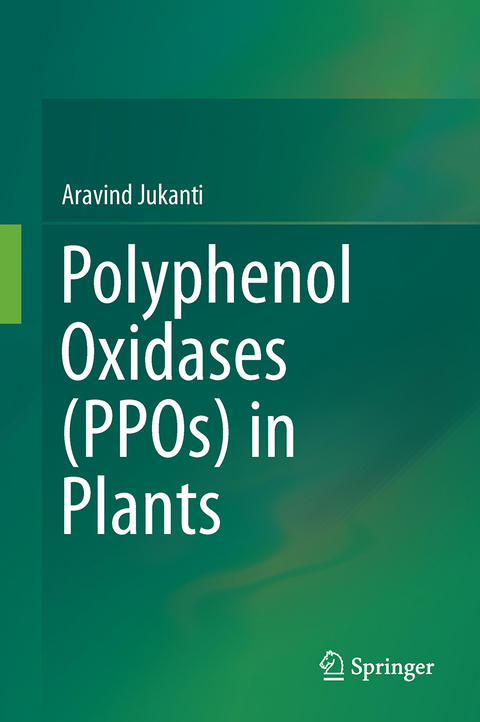
Polyphenol Oxidases (PPOs) in Plants
Springer Verlag, Singapore
978-981-10-5746-5 (ISBN)
) necessary for plastid import. The PPOs occur in latent form that are activated by various treatments including acid and base shock, exposure to detergents or proteolytic degradation. The pH optimum of PPOs varies widely depending upon different plant species but is usually ~4.0 – 8.0. Similarly, the optimum temperature also varies as per the source and substrate involved ranging from 30 to 45 °C.
Multiple PPO isoforms have been reported in several plant species, and the chromosomal location of PPOs has also been studied in some species. The physiological role (s) of PPOs is not entirely understood, but they could be involved in defense-related functions in plants. From an applied perspective, PPOs are implicated in enzymatic browning/darkening of cereal products, vegetables and fruits. Interestingly, browning is preferred in some instances like the processing of black tea, cocoa, and coffee as it enhances their quality by forming flavorful products. There have b
een initiatives to specifically breed and develop cultivars with reasonably low PPO levels in the mature grain or fruit. Further, several types of inhibitors that reduce the PPO activity have also been identified.
Despite their commercial/economic importance and the availability of literature on different aspects of PPOs in different plant species, this is the first book to provide basic information regarding PPOs. It is a valuable resource for researchers involved in quality-related research specifically in crops, vegetables and fruits. Further, as PPOs are also implicated in defense- or stress-related functions, the book is also useful to breeders, pathologists, molecular biologists, physiologists and entomologists.
Aravind K Jukanti obtained both his bachelors (1993-1997) and master’s degrees (1997-1999) in agriculture from Acharya NG Ranga Agricultural University, Hyderabad, India. During his master’s his specialization was in ‘Genetics and Plant Breeding’, working on protein and other quality aspects in babycorn maize. Later, he shifted to Montana State University (MSU), Bozeman, USA on a full scholarship to pursue his PhD in Wheat genetics. The title of his dissertation at MSU was “Molecular and Biochemical Charaterization of Wheat (Triticum aestivum L.) Polyphenol Oxidases”. Aravind Jukanti reported and characterized the wheat PPO multi-gene family. He was also successful in identifying the most important wheat kernel PPO probably involved in the undesirable darkening reaction. After graduating in 2005, he worked as a post-doctoral fellow with Dr. A.M. Fischer at MSU upto 2007, mostly working on grain protein content and nitrogen remobilization in barley. He moved to the lab o f Dr. J. Jaworski during the winter of 2007 at Donald Danforth Plant Science Center (DDPSC), St. Louis, Missouri, USA. At DDPSC he worked on proteomic aspects of triacylglycerol biosynthesis. He moved backed to India in 2009, worked in the chickpea team as a breeder at ‘International Crops Research Insititute for the Semi-Arid Tropics (ICRISAT), Hyderabad, India’ and later joined the ‘Indian Council for Agricultural Research (ICAR)’ as a ‘Senior Scientist’, presently working as a senior pearl millet breeder at Jodhpur, Rajasthan, India.
Chapter 1. Introduction.- Chapter 2. Distribution, Localization and Structure of Plant Polyphenol Oxidases (PPOs).- Chapter 3. Physicochemical Properties of Polyphenol Oxidases.- Chapter 4. Reaction Features of Polyphenol Oxidases.- Chapter 5. Function(s)/Role(s) of Polyphenol Oxidases.- Chapter 6. Polyphenol Oxidases(s): Importance in Food Industry.- Chapter 7. Advances in Polyphenol Oxidase (PPO) Research.
| Erscheinungsdatum | 13.09.2017 |
|---|---|
| Zusatzinfo | 26 Illustrations, color; 15 Illustrations, black and white; VII, 131 p. 41 illus., 26 illus. in color. |
| Verlagsort | Singapore |
| Sprache | englisch |
| Maße | 155 x 235 mm |
| Themenwelt | Naturwissenschaften ► Biologie ► Botanik |
| Technik ► Lebensmitteltechnologie | |
| Schlagworte | Biotechnology • Enzymatic browning • genomics • Proteomics • Stress response |
| ISBN-10 | 981-10-5746-X / 981105746X |
| ISBN-13 | 978-981-10-5746-5 / 9789811057465 |
| Zustand | Neuware |
| Haben Sie eine Frage zum Produkt? |
aus dem Bereich


